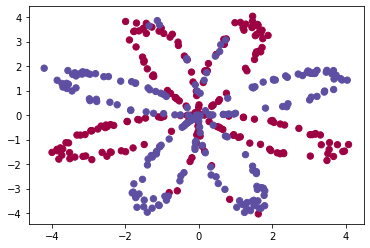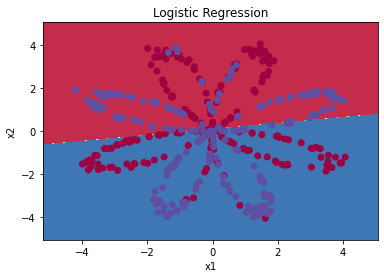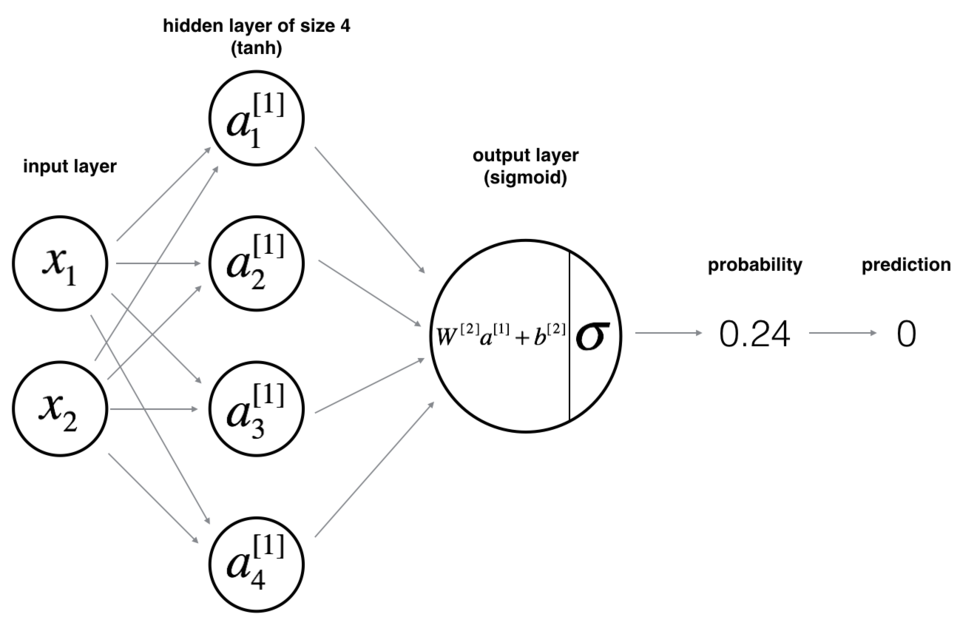欢迎来到第3周的编程作业。 现在是时候建立你的第一个神经网络了,它将具有一层隐藏层。
你将学到如何:
- 实现具有单个隐藏层的2分类神经网络
- 使用具有非线性激活函数的神经元,例如tanh
- 计算交叉熵损失
- 实现前向和后向传播
“flower”数据集可视化:数据看起来像是带有一些红色(标签y = 0)和一些蓝色(y = 1)点的“花”。 我们的目标是建立一个适合该数据的分类模型。
sklearn简单Logistic回归
在构建完整的神经网络之前,首先让我们看看逻辑回归在此问题上的表现。
你可以使用sklearn的内置函数来执行此操作。运行以下代码以在数据集上训练逻辑回归分类器。
# Train the logistic regression classifierclf = sklearn.linear_model.LogisticRegressionCV();clf.fit(X.T, Y.T);# Plot the decision boundary for logistic regressionplot_decision_boundary(lambda x: clf.predict(x), X, Y)plt.title("Logistic Regression")# Print accuracyLR_predictions = clf.predict(X.T)print ('Accuracy of logistic regression: %d ' % float((np.dot(Y,LR_predictions) + np.dot(1-Y,1-LR_predictions))/float(Y.size)*100) +'% ' + "(percentage of correctly labelled datapoints)")
输出:Accuracy of logistic regression: 47 % (percentage of correctly labelled datapoints)
神经网络模型
从上面我们可以得知Logistic回归不适用于“flower数据集”。现在你将训练带有单个隐藏层的神经网络。
这是我们的模型:
数学原理:
例如%7D#card=math&code=x%5E%7B%28i%29%7D&id=zAV90):
%7D%20%3D%20%20W%5E%7B%5B1%5D%7D%20x%5E%7B(i)%7D%20%2B%20b%5E%7B%5B1%5D%20(i)%7D%5Ctag%7B1%7D%0A#card=math&code=z%5E%7B%5B1%5D%20%28i%29%7D%20%3D%20%20W%5E%7B%5B1%5D%7D%20x%5E%7B%28i%29%7D%20%2B%20b%5E%7B%5B1%5D%20%28i%29%7D%5Ctag%7B1%7D%0A&id=pe363)
%7D%20%3D%20%5Ctanh(z%5E%7B%5B1%5D%20(i)%7D)%5Ctag%7B2%7D%0A#card=math&code=a%5E%7B%5B1%5D%20%28i%29%7D%20%3D%20%5Ctanh%28z%5E%7B%5B1%5D%20%28i%29%7D%29%5Ctag%7B2%7D%0A&id=Dd5KW)
%7D%20%3D%20W%5E%7B%5B2%5D%7D%20a%5E%7B%5B1%5D%20(i)%7D%20%2B%20b%5E%7B%5B2%5D%20(i)%7D%5Ctag%7B3%7D%0A#card=math&code=z%5E%7B%5B2%5D%20%28i%29%7D%20%3D%20W%5E%7B%5B2%5D%7D%20a%5E%7B%5B1%5D%20%28i%29%7D%20%2B%20b%5E%7B%5B2%5D%20%28i%29%7D%5Ctag%7B3%7D%0A&id=dfztn)
%7D%20%3D%20a%5E%7B%5B2%5D%20(i)%7D%20%3D%20%5Csigma(z%5E%7B%20%5B2%5D%20(i)%7D)%5Ctag%7B4%7D%0A#card=math&code=%5Chat%7By%7D%5E%7B%28i%29%7D%20%3D%20a%5E%7B%5B2%5D%20%28i%29%7D%20%3D%20%5Csigma%28z%5E%7B%20%5B2%5D%20%28i%29%7D%29%5Ctag%7B4%7D%0A&id=M7EIe)
%7D%7Bprediction%7D%20%3D%20%5Cbegin%7Bcases%7D%201%20%26%20%5Cmbox%7Bif%20%7D%20a%5E%7B%5B2%5D(i)%7D%20%3E%200.5%20%5C%5C%200%20%26%20%5Cmbox%7Botherwise%20%7D%20%5Cend%7Bcases%7D%5Ctag%7B5%7D%0A#card=math&code=y%5E%7B%28i%29%7D%7Bprediction%7D%20%3D%20%5Cbegin%7Bcases%7D%201%20%26%20%5Cmbox%7Bif%20%7D%20a%5E%7B%5B2%5D%28i%29%7D%20%3E%200.5%20%5C%5C%200%20%26%20%5Cmbox%7Botherwise%20%7D%20%5Cend%7Bcases%7D%5Ctag%7B5%7D%0A&id=tnXFC)
根据所有的预测数据,你还可以如下计算损失:
%7D%5Clog%5Cleft(a%5E%7B%5B2%5D%20(i)%7D%5Cright)%20%2B%20(1-y%5E%7B(i)%7D)%5Clog%5Cleft(1-%20a%5E%7B%5B2%5D%20(i)%7D%5Cright)%20%20%5Clarge%20%20%5Cright)%20%5Csmall%20%5Ctag%7B6%7D%0A#card=math&code=J%20%3D%20-%20%5Cfrac%7B1%7D%7Bm%7D%20%5Csum%5Climits_%7Bi%20%3D%200%7D%5E%7Bm%7D%20%5Clarge%5Cleft%28%5Csmall%20y%5E%7B%28i%29%7D%5Clog%5Cleft%28a%5E%7B%5B2%5D%20%28i%29%7D%5Cright%29%20%2B%20%281-y%5E%7B%28i%29%7D%29%5Clog%5Cleft%281-%20a%5E%7B%5B2%5D%20%28i%29%7D%5Cright%29%20%20%5Clarge%20%20%5Cright%29%20%5Csmall%20%5Ctag%7B6%7D%0A&id=qjowO)
建立神经网络的一般方法是:
- 定义神经网络结构(输入单元数,隐藏单元数等);
- 初始化模型的参数;
- 循环:
- 实现前向传播
- 计算损失
- 后向传播以获得梯度
- 更新参数(梯度下降)
我们通常会构建辅助函数来计算第 a-c 步,然后将它们合并为nn_model()函数。一旦构建了nn_model()并学习了正确的参数,就可以对新数据进行预测。
1.定义神经网络结构
# 1.定义神经网络结构(输入单元数,隐藏单元数等)# 定义三个变量: - n_x:输入层的大小 - n_h:隐藏层的大小(将其设置为4) - n_y:输出层的大小def layer_sizes(X, Y):n_x = X.shape[0]n_h = 4n_y = Y.shape[0]return (n_x, n_h, n_y)
2.初始化模型的参数
# 2.初始化模型的参数,权重矩阵为随机值,偏差向量为0def initialize_parameters(n_x, n_h, n_y):np.random.seed(2) # we set up a seed so that your output matches ours although the initialization is random.### START CODE HERE ### (≈ 4 lines of code)W1 = np.random.randn(n_h, n_x) * 0.01W2 = np.random.randn(n_y, n_h) * 0.01b1 = np.zeros((n_h, 1))b2 = np.zeros((n_y, 1))### END CODE HERE ###assert (W1.shape == (n_h, n_x))assert (b1.shape == (n_h, 1))assert (W2.shape == (n_y, n_h))assert (b2.shape == (n_y, 1))parameters = {"W1": W1,"b1": b1,"W2": W2,"b2": b2}return parametersparameters = initialize_parameters(n_x, n_h, n_y)
3.循环
# 3.循环def forward_propagation(X, parameters):# Retrieve each parameter from the dictionary "parameters"### START CODE HERE ### (≈ 4 lines of code)W1 = parameters['W1']W2 = parameters['W2']b1 = parameters['b1']b2 = parameters['b2']### END CODE HERE #### Implement Forward Propagation to calculate A2 (probabilities)### START CODE HERE ### (≈ 4 lines of code)Z1 = np.dot(W1, X) + b1A1 = np.tanh(Z1)Z2 = np.dot(W2, A1) + b2A2 = sigmoid(Z2)### END CODE HERE ###assert(A2.shape == (1, X.shape[1]))cache = {"Z1": Z1,"A1": A1,"Z2": Z2,"A2": A2}return A2, cacheA2, cache = forward_propagation(X_assess, parameters)
计算损失函数 如下:
%7D%5Clog%5Cleft(a%5E%7B%5B2%5D%20(i)%7D%5Cright)%20%2B%20(1-y%5E%7B(i)%7D)%5Clog%5Cleft(1-%20a%5E%7B%5B2%5D%20(i)%7D%5Cright)%20%5Clarge%7B)%7D%20%5Csmall%0A#card=math&code=J%20%3D%20-%20%5Cfrac%7B1%7D%7Bm%7D%20%5Csum%5Climits_%7Bi%20%3D%200%7D%5E%7Bm%7D%20%5Clarge%7B%28%7D%20%5Csmall%20y%5E%7B%28i%29%7D%5Clog%5Cleft%28a%5E%7B%5B2%5D%20%28i%29%7D%5Cright%29%20%2B%20%281-y%5E%7B%28i%29%7D%29%5Clog%5Cleft%281-%20a%5E%7B%5B2%5D%20%28i%29%7D%5Cright%29%20%5Clarge%7B%29%7D%20%5Csmall%0A&id=ucZPG)
def compute_cost(A2, Y, parameters):m = Y.shape[1] # number of example# Compute the cross-entropy cost### START CODE HERE ### (≈ 2 lines of code)logp = np.multiply(np.log(A2),Y) + np.multiply((1 - Y), np.log(1-A2))cost = -1/m * np.sum(logp)### END CODE HERE ###cost = np.squeeze(cost) # makes sure cost is the dimension we expect.# E.g., turns [[17]] into 17assert(isinstance(cost, float))return costprint("cost = " + str(compute_cost(A2, Y_assess, parameters)))
接下来实现反向传播,根据图中右侧的公式即可。
def backward_propagation(parameters, cache, X, Y):m = X.shape[1]W1 = parameters['W1']W2 = parameters['W2']A1 = cache["A1"]A2 = cache['A2']# Backward propagation: calculate dW1, db1, dW2, db2.### START CODE HERE ### (≈ 6 lines of code, corresponding to 6 equations on slide above)dZ2 = A2 - YdW2 = 1/m * np.dot(dZ2, A1.T)db2 = 1/m * np.sum(dZ2, axis = 1, keepdims=True)dZ1 = np.dot(W2.T, dZ2) * (1 - np.power(A1, 2))dW1 = 1/m * np.dot(dZ1, X.T)db1 = 1/m * np.sum(dZ1, axis = 1, keepdims=True)### END CODE HERE ###grads = {"dW1": dW1,"db1": db1,"dW2": dW2,"db2": db2}return gradsgrads = backward_propagation(parameters, cache, X_assess, Y_assess)
# 更新参数def update_parameters(parameters, grads, learning_rate = 1.2):W1 = parameters["W1"]b1 = parameters["b1"]W2 = parameters["W2"]b2 = parameters["b2"]dW1 = grads["dW1"]db1 = grads["db1"]dW2 = grads["dW2"]db2 = grads["db2"]# Update rule for each parameter### START CODE HERE ### (≈ 4 lines of code)W1 = W1 - learning_rate * dW1b1 = b1 - learning_rate * db1W2 = W2 - learning_rate * dW2b2 = b2 - learning_rate * db2### END CODE HERE ###parameters = {"W1": W1,"b1": b1,"W2": W2,"b2": b2}return parametersparameters = update_parameters(parameters, grads)
# 在 nn_model() 中集成上面的函数def nn_model(X, Y, n_h, num_iterations = 10000, print_cost=False):np.random.seed(3)n_x = layer_sizes(X, Y)[0]n_y = layer_sizes(X, Y)[2]# Initialize parameters, then retrieve W1, b1, W2, b2. Inputs: "n_x, n_h, n_y". Outputs = "W1, b1, W2, b2, parameters".### START CODE HERE ### (≈ 5 lines of code)parameters = initialize_parameters(n_x, n_h, n_y)b1 = parameters['b1']b2 = parameters['b2']W1 = parameters['W1']W2 = parameters['W2']### END CODE HERE #### Loop (gradient descent)for i in range(0, num_iterations):### START CODE HERE ### (≈ 4 lines of code)A2, cache = forward_propagation(X, parameters)cost = compute_cost(A2, Y, parameters)grads = backward_propagation(parameters, cache, X, Y)parameters = update_parameters(parameters, grads, learning_rate = 1.2)### END CODE HERE #### Print the cost every 1000 iterationsif print_cost and i % 1000 == 0:print ("Cost after iteration %i: %f" %(i, cost))return parametersparameters = nn_model(X_assess, Y_assess, 4, num_iterations=10000, print_cost=False)
预测
# 使用正向传播来预测结果。def predict(parameters, X):# Computes probabilities using forward propagation, and classifies to 0/1 using 0.5 as the threshold.### START CODE HERE ### (≈ 2 lines of code)A2, cache = forward_propagation(X, parameters)predictions = np.round(A2)### END CODE HERE ###return predictionspredictions = predict(parameters, X_assess)
现在运行模型以查看其如何在二维数据集上运行。 运行以下代码以使用含有 𝑛_ℎ 隐藏单元的单个隐藏层测试模型。
# Build a model with a n_h-dimensional hidden layerparameters = nn_model(X, Y, n_h = 4, num_iterations = 10000, print_cost=True)# Plot the decision boundaryplot_decision_boundary(lambda x: predict(parameters, x.T), X, Y)plt.title("Decision Boundary for hidden layer size " + str(4))# Print accuracypredictions = predict(parameters, X)print ('Accuracy: %d' % float((np.dot(Y,predictions.T) + np.dot(1-Y,1-predictions.T))/float(Y.size)*100) + '%')

Accuracy: 90%

